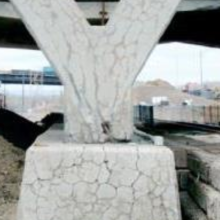ODOBA project
The ODOBA (Observatory of the durability of reinforced concrete structures) project was launched by IRSN in 2016 for a period of at least 10 years. The aim of the project is to study concrete pathologies and their consequences for nuclear structures (e.g. Reactor containments). The project is led in collaboration with the NRC (Nuclear regulatory authority, US safety authority) , CNSC (Canadian nuclear safety commission), Bel V (Belgian TSO (technical sfety authority)) and VTT (Technical research center of Finland). NSC (Chinese TSO) should soon join the project.
Context and Objectives
Nuclear reactors were initially designed to operate for 40 years, but operators, such as EDF, would like to extend their service life up to 60 years, and some operators in the United States are even considering up to 80 years. In general, new installations are currently purpose-designed to operate for 60 years, such as the Flamanville EPR, and at least 150 years for the CIGÉO deep geological disposal site, where concrete plays a safety and functional role throughout the operating and reversibility phase.
Over such operating periods, concrete can be affected with pathologies resulting from the chemical reactions that take place within it. These pathologies may lead to degradation of the concrete’s mechanical properties and its ability to ensure the containment of radioactive materials.
Such phenomena have not only been observed on civilian structures (bridges, dams) but also on some nuclear installations: Gentilly-2 in Canada, Seabrook in the United States, Tihange-2 in Belgium, etc. The risk of such pathologies developing on the French fleet’s installations is considered sufficiently credible for specific studies to be launched, of which the ODOBA project.

In 2014 and 2015, the OECD /NEA1 commissioned the ASCET2 working group to assess the extent of knowledge on concrete pathologies and express the needs for improving this knowledge which amounts to: performing tests on large structures in order to complement the tests usually carried out in small laboratories; studying the combined effects between various pathologies; developing non-destructive testing methods and predictive digital tools, etc.
The objectives of the ODOBA project are to meet the following recommendations:
- Better understand the phenomena involved in concrete pathologies and the combinations between the various pathologies.
- Develop and validate non-destructive testing techniques for early detection of the occurrence of pathologies then monitor their evolution.
- Develop and validate simulation tools for predicting concrete behavior on the structural scale.
1 Organisation for economic co-operation and development/Nuclear energy agency
2 Assessment of structures subject to concrete pathologies
Project workflow
The ODOBA project mainly involves performing tests on large concrete structures (4 x 2 x 1 m) on IRSN's ODE platform (Observatoire de la Durabilité des Enceintes - Containment durability observatory), located in Cadarache (Bouches-du-Rhône). Some of the concrete blocks will be subjected to accelerated aging protocols to simulate long operating periods.
The ODE platform consists of a 1700 m² exterior testing slab that can host up to 60 experimental blocks. It is equipped with equipment for managing the effluents generated by accelerated aging protocols (mineral-laden water).
The first five blocks were cast in 2016. New blocks will be cast every year as the project progresses and tests are defined by the partners. The various parameters of interest characterizing the test conditions are as follows: nature of the constituents of the concrete, effect of steel reinforcement and pre-stressing, impact of “environmental” conditions (humidity, CO2 in the air or aquifer, groundwater (e.g. sulfates), conditions with the young age of the concrete (initial weeks after casting), and accelerated aging protocol, etc.
The following are currently in place or planned:
- A reference block without pathologies.
- Blocks dedicated to Alkali–silica reaction (ASR): a reaction that occurs between the highly alkaline cement paste and the reactive silica found in certain aggregates.
- Blocks dedicated to studying delayed ettringite formation (DEF). This reaction is thermally activated (significant heating of the concrete) within the cement paste.
- Blocks for the combined ASR and DEF study.
- Blocks dedicated to deep geological disposal facilities: effect of highly saline groundwater.
- A block dedicated to the development of non-destructive examination methods.
- Twin blocks, with and without steel reinforcement, to characterize the effect of this reinforcement.
The concrete blocks used for the ODOBA project are extensively instrumented in order to obtain various types of data, such as, temperature, humidity, deformation, mechanical stress measurements within the concrete and/or steel reinforcement. The blocks periodically undergo non-destructive and destructive testing to assess changes to the mechanical, physical, micro-structural and chemical properties of the concrete linked with the occurrence and development of pathologies.
Some blocks will be subjected to accelerated aging protocols to reproduce the service life of an installation (40 to 60 years for reactors and up to 150 years for geological disposal facilities) within reasonable time scales (2-3 years). The solution retained involves constructing tanks around the blocks to carry out immersion/drying cycles controlling the temperature and chemistry of the water. The first “aging pool” will be commissioned in autumn 2018 for qualification prior to deployment on the blocks from 2019.
Given the kinetics of the phenomena, the first results are expected approximately 2 years after casting the blocks.
The results of the ODOBA project will eventually make it possible to develop and validate predictive simulation tools concerning the occurrence and development of pathologies and their consequences on the mechanical and containment properties of concrete on the structural scale. They will also help to assess the non-destructive examination methods.
